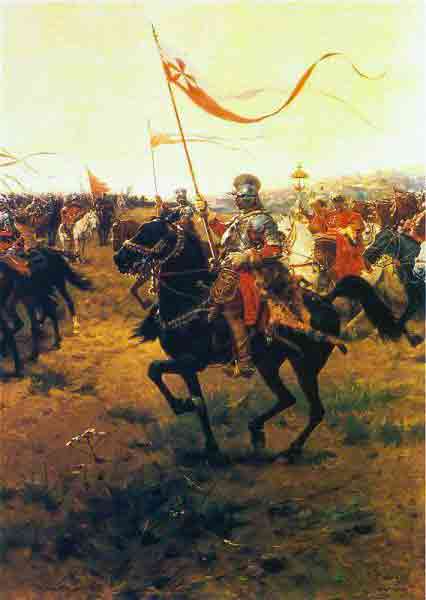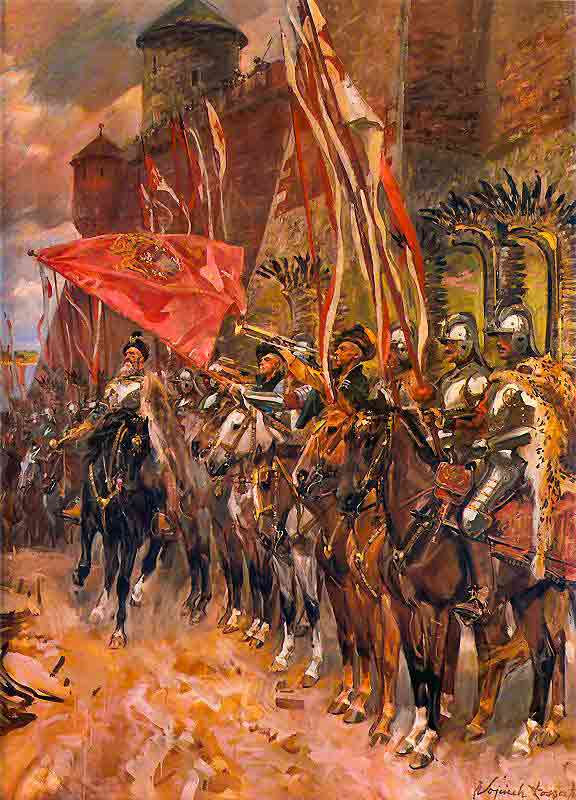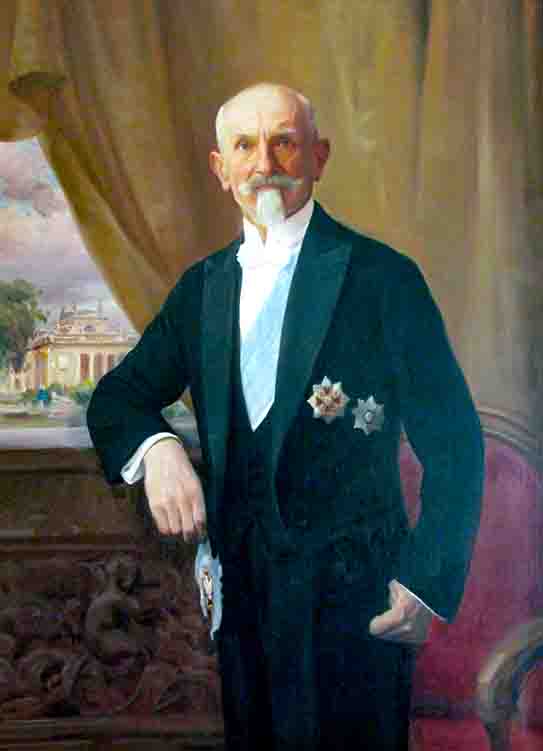In the film "The Last Samurai" with Tom Cruise, in the final scenes, the charge of a mounted samurai unit on enemy positions is shown. This happens in 1877. All samurai are killed. If this scene had taken place 100 years earlier in what was then Eastern Europe, a squad of riders would have won, and in heavy armor, which fulfilled the role of today's bulletproof vests, using 6-meter copies, they would have obliterated all the infantrymen. However, there were no modern and accurate machine guns back then. These riders from Eastern Europe were Polish hussars.

Hetman's Guard, painting by Wacław Pawliszak
The hussar formations were established by the Polish Seym (Parliament) in 1503 and were dissolved by the same Seym in 1775, as a result of their transformation into the National Cavalry formations. For 272 years of existence, the hussars achieved spectacular successes, beating the enemies of Poland in those times, from Denmark to Moscow, which the Poles occupied for over two years, from October 9, 1610 to November 7, 1612; from the Black Sea to Vienna, which, along with all of Europe at that time, was saved from Turkish troops by the Polish King Jan III Sobieski in the battle that took place near Vienna on September 12, 1683.
To illustrate the successes of Hussars, I will first mention selected historical battles:
On September 8, 1514, the battle of Orsza. The Grand Hetman of Lithuania Konstanty Ostrogski, having about 30,000 troops, defeated about 80,000 Moscow troops under the command of Ivan Czeladin.
September 27, 1605, Battle of Kircholm. Hetman Jan Karol Chodkiewicz, having around 3,500 Polish troops, defeated 11,000 Swedish troops under the command of Karol Sudermanski. Polish losses amounted to 100 killed, including 13 hussars, Swedish losses from 6,000 to 9,000 killed.
On July 4, 1610, the battle of Kluszyn. The Field Hetman of the Crown, Stanisław Żółkiewski, having about 6,000 cavalry, after an all-night march, strikes the Moscow army led by Prince Dymitr Szujski (approx. 20,000) and the Swedish army, led by Jakub Pontusson De la Gardie (approx. 4,000), and destroys them. The victory opens the way to Moscow, which the Polish Army occupied for two years.
June 11, 1694, the battle of Hodów. 400 warriors (100 hussars and 300 armored riders) defend themselves partially on foot in the buildings of the village of Hodów against about 40,000 Tatar troops (some sources even state the number of 70,000 Tatars). Polish losses less than 100, Tatar losses about 2-4 thousand. In the face of fierce resistance, the Tatars retreat. After the battle, several carts of usable arrows were assembled. To commemorate this battle, King Jan III Sobieski founded a monument in Hodów, which has existed to this day.
As a reminder, in the historic Battle of Thermopylae, which took place in 480 BC, 300 Spartans under the command of Leonidas are all killed in a battle on the isthmus, stopping the approximately 300,000-strong Persian army under the command of Xerxes I. To call the Hussar Warriors the Defenders of the Polish Thermopylae is offensive as, unlike the Spartans, they won the battle of Hodów. There were hundreds of such Hussar battles during the formation's existence.
How was it possible that the Polish Hussars were able to defeat many times more numerous troops of other nations with relatively small forces?

Hussar, painting by Józef Brandt
The strength of the Polish Hussars was primarily determined by very high morale, but also excellent weapons, adapted to the battlefield of the period, as well as a high level of training and regular, grueling practice. It was the GROM [Polish Special Forces], Navy Seals, SAS, or Delta Force of the time.
Only the best could get into the hussar formations, and besides, only the richest could afford it, because hussars most often paid extra, and a lot of money, for the privilege of service.
I wonder what to compare the former hussars in attack today and I can only think of one comparison. See what the Leopard II A5 tank, accelerated to 60-70 km per hour, looks like driving straight ahead. I saw it for real. It was in a forest training ground. The ground shook and the bark of the trees trembled. Unstoppable power.
In addition to the perfect skill of using a saber or a lance, the hussar training involved, among other things, to accelerate the horse over a short distance of the road in full gear, then to stop it almost in place, turn back and gallop again, braking again, and turning back. There was no special breed of hussar horses, but there were special breeding grounds, where the largest, strongest and most enduring horses were selected. In addition, the horses from their time as foals were getting used to the sounds and smells that they would later encounter in the service of the Hussars. It was forbidden to sell such horses abroad under the penalty of the throat - that is, under the penalty of death.
The basic armament of the hussar was a lance. The weapon was dropped in Western Europe as too heavy, difficult to operate, requiring constant training, and of little use in city fights. Meanwhile, Polish hussars used lances as a basic weapon to break the enemy ranks, but it was a weapon that was improved and different from the one used in the times of knights clad in full armor.
The Hussar's lance was solid wood from the base to the vamplate, and from the vamplate to the tip it was hollowed after having been cut into two parts, then glued together and braided with ropes for additional reinforcement. Such a lance was much lighter than those made from a single piece of wood, and the distribution of the weight ¼ to ¾ facilitated its aiming at a specific target.
On the way to the battlefield, lances were transported on carts. It was only in the immediate vicinity of the enemy that the hussar picked up the lance into his hand and while riding a horse, kept it in a special leather holster, attached to the saddle by straps.
As has already been said, lances were a breakthrough weapon. After hitting the enemy, they broke into pieces and the hussar had to use another one for the next charge. There was not a single length for a lance. The longest one in museum collections measures 6.20 m. On average, lances measured from 4.50 m to 5.80 m. Taking into account that the longest pikes measured from 3.80 to 4.5 m at the time — the advantage in the length of the hussars' lances made a fundamental difference in favor of the hussars.
The hussar was also armed with a koncerz - a two-meter stabbing sword, with a tri- or quadrangular cross-section which, after hussar's having crushed the lance, rested on the hussar saddle and was used to pierce enemy infantrymen. The hussar also had a saber, two guns in holsters, a recurve bow, a hammer (on a long handle).
The weapons were selected depending on the opponent. For example, pistols were most effective against the Tatars, but not because they could hit the enemy. The anti-Tatar guns worked well because the Tatar horses were not used to the sound of a shot and panicked. After firing a shot, the Tatar rider most often had to fight with his horse in order to control it, and the hussar's attack was easier.
Starting the charge, the Hussar lowered the lance, which was still stuck in the peg attached to the saddle. In this way, the Hussar obtained a lever, which on the one hand made it easier to hold the lance itself, and on the other hand, the weight of the horse was added to the strength of the lance's impact. Being hit with such a lance was unstoppable. Back then, there was no sheet metal that could not have been pierced by such an impact. A chronicle describes a record at the time when, during the battle of Połonka on June 28, 1660, a hussar impaled 6 infantrymen on the lance. Two or three enemies pierced on one lance happened very often and did not cause a sensation.
The hussar's armor was a breastplate with flaps (sheet metal tabs that made it possible to bend the armor) and shoulder pads of the same material. The head was protected by a helmet shielding the neck and cheeks, and from the front, the face was protected by a detachable nose piece. On his back, the hussar was covered with the skin of a predator: a wolf, a leopard, a bear. Paradoxically, the hussar armor did not weigh much, only about 16 kilograms. For comparison: backpacks of today's soldiers can weigh 23-25 kg.
The plates of the hussar's breastplate were sloped, like the armor of today's tanks, and even for the same purpose, so that the bullets or blades would slide across them without damaging the hussar. In general, the Hussar "plates" were checked in such a way that they had to withstand a shot from a pistol at close range. The breastplate, which was pierced by a bullet, was not suitable for a Hussar.
The Hussars attacked in dense formations riding "in-the-knee", that is, the riders touched their knees during the gallop. The hussars hit the enemy with one solid "wall" composed of 50-100, and sometimes even 200, riders in one row - depending on the number of hussars. Behind the first row stood the second row, rarely the third one.

Hussars, painting by Wojciech Kossak
During the battle, if the hussar unit (rota) was stretched over 100 meters, and a unit of pikemen mixed with musketeers which was 30-50 meters wide stood opposite of it, the speeding roller of the hussars hit the enemy in the middle, and the rota's wings curled around the enemy and after a few moments it was reported that the enemy had "been utterly annihilated."
The dressage of a horse was very important. The horse is a rather skittish animal who reacts to noises to which it is not accustomed, most often with nervousness, panic or by running away. The hussars made full use of this feature, adjusting their way of fighting according to the enemy with whom they had to fight.
When going against the Tatars, firearms were used heavily, because Tatar horses did not know the sounds of shots on a daily basis. The attacking hussars had long banners at the ends of their copies, which made such a terrible sound that the horses of all opponents panicked. The skins of wild animals on the backs of hussars had a similar effect on horses.
Horses are naturally afraid of predatory animals. They have it in their genes. The smell of a wolf is very pungent and characteristic. The charging hussars themselves aroused fear with their sight and scared the horses and riders of the enemy. But when the smell of attacking 100 wolves reached the horses' nostrils, the lance's very often hit the opponent when his horses were just beginning to rear and refuse to obey.
Today, hussars are associated with characteristically bent two wings. There were wings, but not every hussar wore them and most often, it was just one wing attached to the saddle.
The wings should not protrude above the rider's head so that he can fight freely using the saber. The wings are absent in Pieter Snayers' Battle of Kirholm 1605 painting .
And why did hussars even have wings? You might as well ask why today's soldiers paint their faces black or why MMA fighters tattoo their bodies, or why New Zealand's players do a haka before matches. It is more intimidating this way. This weakens the opponent's morale. In addition, the attachment of the wings optically increases the size of the unit 2-3 times. There were battles described in history, which did not take place at all, because the opponents, as soon as they saw the Hussar lances, banners and wings, would leave in panic.

A contemporary reenactment of a Hussar
And were the firearms (muskets, pistols) a threat to the hussars? I will answer with the help of a cinema classic. In Quentin Tarantino's Pulp Fiction, in a scene in an apartment, a nervous student jumps out of a locked room and shoots a 6-shot revolver at Vincent Vega (John Travolta) and Jules Winnefield (Samuel L. Jackson) from a distance of several meters. None of the bullets hit their targets. Anyone who has dealt with firearms knows perfectly well that this scene is real. Being in a heightened emotional state, with a handgun, you can miss the target a few meters away from the shooter.
Firearms were very inaccurate to fast-moving targets and there was hardly any time to fire a second shot. The imposing brim of the musketeer's hat served as a veil to protect his eyes when the gunpowder exploded during a shot. It was a natural reflex - to hide the eyes when the gunpowder explodes while firing a shot, but in such a situation you cannot speak of aiming at all - which also explains the minimal losses of the hussars.
In the times of the hussars, firearms and the way they were used were so imperfect that the historically recorded losses in terms of people in clashes between hussars and musketeers or pikemen in battle amounted to two or three killed hussar companions, as well as several pages and servants. Many more horses were killed.
Polish hussars and Japanese samurai are military formations that fascinate us to this day. Although so distant in time, the geographical space, and cultures they represent, they are vividly reflected in the contemporary imagination. Their bravery and courage impress us no matter where we live.
If you have any questions, please contact: fundacjablasiaka@gmail.com or visit the website fundacjablasiak.pl/english/ .
This and other information came from the book by Radosław Sikora "Husaria. The pride of the Polish Forces" (Husaria. Duma polskiego oręża), Znak Horyzont Publishing House, Krakow 2019.
All photos are from Wikipedia.
Translation from Polish by Andrew Woźniewicz.





